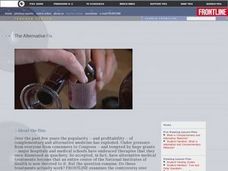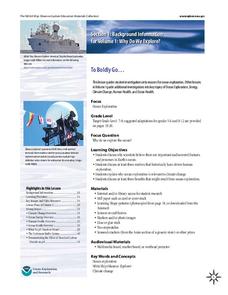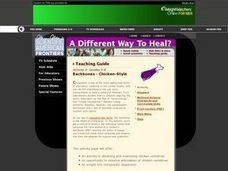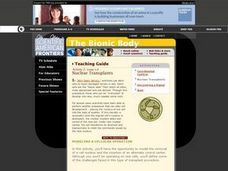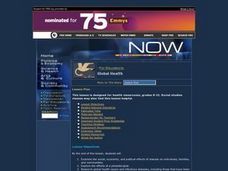Curated OER
The Alternative Fix: What Is Complementary and Alternative Medicine?
High schoolers study the use of alternative and complementary medicines. They research the five categories of CAM therapies and how popular they are. They report their finding to the rest of the class.
Curated OER
Medicine, Technology and Society
High schoolers compare and contrast traditional Chinese and contemporary Western approaches to medicine. They bring a rational and scientific approach to the evaluation of alternative medicines. They study acupuncture from a Chinese and...
Curated OER
Benefits, drawbacks of alternative healing
Students discuss alternative healing techniques, then chart the potential benefits and drawbacks of alternative health therapies. They design symbols representing alternative healing techniques.
Curated OER
Traditional Remedies
Students discover alternative medicines from around the globe. In this world culture instructional activity, students read text from Africa, Ireland, Tibet and Tanzania discussing known remedies to diseases. Students discuss...
Curated OER
Herbal Medicines
Students become critical thinkers about substances that are called medicines and it guides them into an inquiry process of carrying out their own investigations of the attributes of some common herbal remedies.
Curated OER
Student Viewing Guide: "The Alternative Fix"
Students discuss the merits of and problems with alternative medicines after watching a documentary entitled "The Alternative Fix." They discuss the documentary after completing the viewing guides.
Curated OER
The Alternative Fix
Young scholars explore the history of the government's involvement in medicine. They examine the popularity of alternative medicine in today's society and the dangers that some alternative medicines may pose. Students research the...
Curated OER
Herbs: Healthy Alternatives or Bad Medicine??
Young scholars compare herbal and pharmaceutical remedies for common ailments.
National First Ladies' Library
A Blessing in Disguise
Young scholars study the history of polio as well as a history of modern medicine, the history of alternative medicine and the role of the scientific method in each of these histories. They review the scientific method and research...
NOAA
To Boldly Go...
When we think of ocean exploration, many of us have visions of sunken pirate ships full of treasure or mysterious creatures of the deep. What really motivates deep-sea investigation? The first in a series of diverse six-part lessons...
Curated OER
Backbones - Chicken-Style
Students observe individual bones that comprise the neck portion of a chicken's backbone. After cleaning the bones of tissue, they examine the dried vertebrae and observe how they are adapted for support and protection.
Curated OER
What's important? Knowing your facts, yourself and your role models
Third graders review safety rules about alcohol, tobacco and medicines. They learn healthy alternatives to using alcohol, tobacco and medicines. They recognize healthy and unhealthy choices
Curated OER
That's Dope - Part 1
Students investigate drugs in sports. In this performance enhancing drugs lesson, students discuss the uses for steroids in medicine and sports. Students utilize the web to play a steroid related game, view media clips of their favorite...
Baylor College
Lungometer
Life science learners construct lung-o-meters from gallon-sized milk jugs and then measure their lung capacities. For older students, have them graph the vital lung capacities of each person in the class. Cross-curricular pieces are...
BioEd Online
Muscles and Bones: Nutrition
Got milk? Or almonds, sardines, or tofu? Calcium is important throughout life, but especially so for developing bodies. If teens do not consume enough calcium while they are growing, they are at a much higher risk of osteoporosis and...
Curated OER
Packaging Your Product!
Fifth graders discuss the functions, benefits and drawbacks of packaging. In this product package lesson students design alternative packaging and write an essay to deal with the issues of packaging.
Curated OER
Nuclear Transplants
High schoolers model the removal of a cell nucleus and the insertion of an alternate control center. They define some of the challenges faced in this type of transplant procedure. Students discuss cloning.
Curated OER
Echinacea No Cure all for Kids
Young scholars look at real data and answer the question of whether or not they would recommend Echinacea to cure a cold. In this investigative lesson students describe whether the data supports the hypothesis that echinacea shortens the...
Curated OER
Progressive Era: Public Pressure and Government Actions
Students read sections of the novel, "The Jungle". They identify the problems of the meat industry during the Progressive Era. They discuss food concerns of today and make connections between the two time periods.
Curated OER
Global Health Issues
Examine global health issues and the philanthropic efforts of Bill Gates. Working in groups, your class will research selected diseases focusing on symptoms, transmission, and prevention. They also conclude by writing grant proposals to...
Curated OER
The Scientific Method, Blood Typing, and Antibiotic Resistance
Students are given some components of an experiment, where they are able to identify and fill in missing parts, such as hypothesis, conclusion, results, etc. They form a hypothesis given general scientific facts. Students apply the...
Teach Engineering
Hydrogen-Oxygen Reaction Lab
High schoolers conduct an experiment using the reaction of hydrogen and oxygen. After pairs balance the chemical equation for making water, they mix different ratios of hydrogen and oxygen in a chemical reaction. Classmates...
Curated OER
Medical Pioneers
Students use research skills to take notes over fifteen current medical innovators or innovations. They prepare a PowerPoint presentation over their chosen fifteen medical innovators and innovations. Students show a correlation between...
Curated OER
What's In The Forest?
Students examine forest food chains and create a forest habitat in the classroom. They are introduced to the concept of interdependence in Nature. They define a simple forest food chain and develop inquiry process skills.








